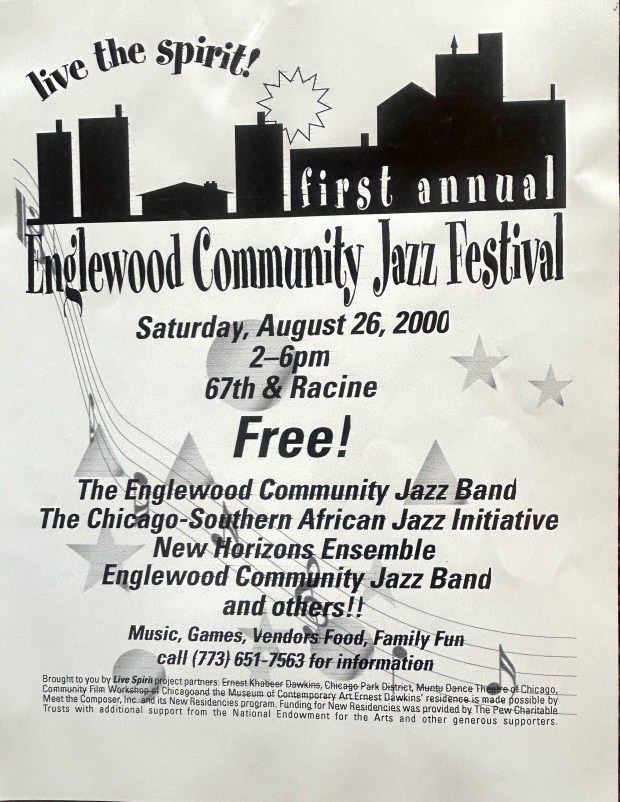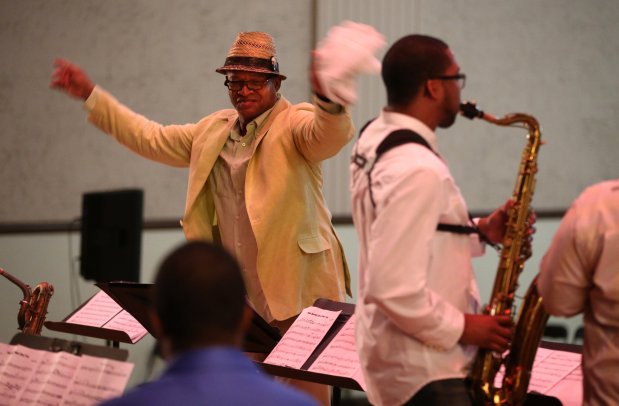Talk to Englewood Jazz Festival founder and director Ernest Khabeer Dawkins for any span of time, and he’ll sound off on one of the city’s great cultural scandals: the dearth of jazz venues on the South Side.
Sure, there are the many series and initiatives now linked to the University of Chicago — essential if penitential, seeing as that many-headed hydra was, for decades, also responsible for choking out surrounding jazz clubs and affordable housing. Other independent presenters persist, too, like the Hyde Park Jazz Fest and its Back Alley Jazz series, and Sundays at Norman’s Bistro in Kenwood, where Dawkins, a saxophonist, is a regular.
But none operate at quite the scale Dawkins is envisioning — and Dawkins likes his projects big. Dawkins is a repeat chair of the Association for the Advancement of Creative Musicians, the collective that forever secured the South Side’s stamp on improvised and experimental music across the globe. He leads the New Horizons Ensemble, a wide-ranging and prolific outfit with chameleon ranks, and has been a member of Kahil El’Zabar’s Ethnic Heritage Ensemble.
His Englewood Jazz Festival comes close. For 25 years now, Dawkins has hosted this mighty festival at Hamilton Park, off 72nd Street. Falling between the Chicago and Hyde Park Jazz Fests every year, the Englewood bash tends to be “a joyous celebration of the jazz avant-garde,” as former Tribune critic Howard Reich dubbed the festival at its 10-year mark.
“It’s a working-class neighborhood, known for high art,” Dawkins says of Englewood.
This year’s festival is not just a joyous celebration. It’s also a joyous reunion. Headliners from years past will converge on Hamilton Park starting Thursday: Flutist Nicole Mitchell, trumpeter Corey Wilkes, saxophonist Greg Ward and bassist Junius Paul all passed through Dawkins’ Live the Spirit Band, and drummer Jeremiah Collier previously participated in the Young Masters program, Dawkins’ latest vehicle for young musicians. After the festival’s finale — an encore performance of “Man of the People,” Dawkins’ and writer Lasana D. Kazembe’s “jazz poetry opera” about Paul Robeson — those musicians and as many festival alums as Dawkins can find will descend on the outdoor stage for a blowout jam session.
Even when the festival attracts big-leaguers like saxophonist Kenny Garrett (in 2022) and trumpeter Sean Jones (2023), its emphasis on community music-making remains at the fore. It’s too baked in Dawkins’ DNA to be otherwise. He grew up in a few neighborhoods on Chicago’s South Side: Bronzeville, Washington Park and Englewood. (Today, Dawkins makes his home in Englewood, living in a home that his grandparents, aunt and cousins once owned.) He got a late start on the saxophone, playing bass and drums until he was 18. But he fell fast and hard for the instrument — plus he could take it along to Washington Park, where he practiced whenever he got booted out of the house for noise.
During one of those exiles, a couple of AACM musicians, including bassoonist James Johnson, encouraged Dawkins to enroll in the AACM School, which educated many second- and third-generation musicians still associated with the collective. It was a trial by fire. Dawkins remembers being made to play “Hot House” at his very first lesson — in front of sax virtuosos Roscoe Mitchell and Chico Freeman, to boot.
“They didn’t give me ‘Little Sunflower.’ They didn’t give me anything melodic!” he says, through hearty laughter.
A few decades and a globe-trotting career later, Dawkins was looking to start a neighborhood festival in Chicago. He considered kicking off in Roseland and Austin, also chronically disinvested Black communities. Instead, Dawkins stuck to what he knew — and what he knew was Englewood. Another set of cousins had lived just down the street from Hamilton Park, the festival’s digs from its second year onwards.
The very first Englewood Jazz Festival, in 2000, was held in Ogden Park. It featured the first outing of the Live the Spirit Band, Dawkins’ big band showcasing ascendant talent; back then, it was called the Englewood Community Band. Besides that, Dawkins says, he doesn’t remember much from that festival. It was all a frenetic blur.
But it was at least paid for. The Englewood Jazz Festival was initially supported by a three-year grant by New York–based organization Meet the Composer. (After a 2011 merger, the nonprofit became New Music USA, a granting organization with a similar purview.)
When that funding ran out in 2002, the festival entered a scrappy period. Dawkins “passed a bucket” during performances, then picked up the other expenses — ergo, most of them.
“It was pretty much me back then,” Dawkins admits.
In a testament to the festival’s mission and Dawkins’ own reputation, for years, musicians agreed to play at discounted rates or donate their services. Dawkins doesn’t take that for granted, two decades on.
“That’s why this (year) is a dedication to the musicians,” he says. “They helped the festival thrive and survive.”

In 2007, Dawkins incorporated Live the Spirit Residency as a nonprofit, using it to administrate the festival, the Young Masters program and other educational programming he oversees at Hamilton Park over the summer. The incorporation has opened up enough new funding streams that it’s no longer necessary to pass that bucket — though donations are certainly welcome.
In the meantime, Dawkins is still dreaming big. The last day of the festival hosts a panel of Black jazz presenters on the South Side to discuss the lack of venues. (Tellingly, the panel is so small that Dawkins is considering expanding the talk’s geographic bounds.) And next year’s festival will be a 60th anniversary tribute to the AACM. It’s already half-booked.
Someday, Dawkins wants to pay the collective’s influence forward even further by establishing a “musical institute on the South Side,” not unlike the AACM School. For now, though, he doles out priceless professional advice through his Young Masters, who perform after the festival panel on Sept. 21. Like: Yes, you do need to sign up for BMI and ASCAP — the organizations which allow musicians to collect royalties on their original compositions.
And: No, don’t just wear whatever you had on earlier that day to a gig.
“As James Brown would say, whatever it is, it has to be funky,” says Dawkins.
Hannah Edgar is a freelance critic.
Sept. 19 in Hamilton Park Fieldhouse
6 p.m.: Junius Paul, bass
7 p.m.: Jahari Stampley, piano
Sept. 20 in Hamilton Park Fieldhouse
6 p.m.: Jeremiah Collier, drums
7 p.m.: Nicole Mitchell, flute
Sept. 21 outdoors in Hamilton Park
Noon: Black South Side Jazz Presenters panel
1 p.m.: The Young Masters, directed by Ernest Dawkins
2:15 p.m.: Corey Wilkes, trumpet
3:30 p.m.: Greg Ward, saxophone
4:30 p.m.: Presentation of the annual Spirit of Jazz Award
4:45-6 p.m.: “Paul Robeson: Man of the People”
The Englewood Jazz Festival runs Sept. 19-21 at Hamilton Park, 513 W. 72nd St.; free; more information at englewoodjazzfestival.org



